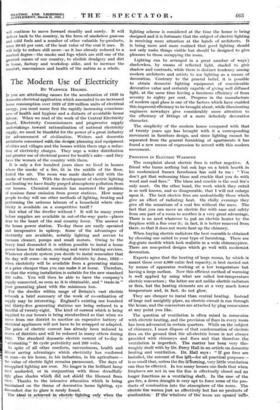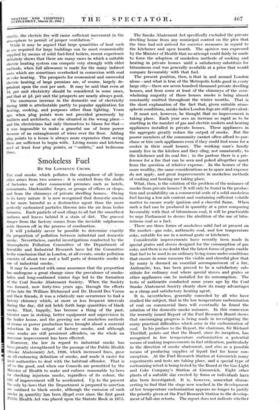The Modern Use of Electricity
ET WARWICK HOLM:ES.
le you are attributing causes for the acceleration of 1930 in domestic electrical application which amounted to an increased home consumption over 1929 of 2200-million units of electrical energy, you must name first the rapidly increasing conscious- ness of health and hygiene and a distaste of avoidable house labour. When we read of the work of the Central Electricity Board, Electricity Commissioners and progressive supply undertakings . toward rationalization of national electricity supply,-we must be thankful for the power of a great industry for advancement of civilization. Writers and domestic architects concerned.with.the designs; planning and equipment of cities and villages and the homes within them urge a reduc- tion of electricity .charges. They urge a wider distribution and greater use of electrical:power for health's sake—and they have the women of the country with' them.
It is only a few hundred years since we lived in houses where the smoke of a fire, lit in the middle of the floor, fouled the air. The room was made darker still with the smoke of torches. With the development of electric lighting and heating wehave finally purged atmospheric pollution from our houses. Chemical research has mastered the problem of noxious fume emission from power stations. How many people to-day will use other methods of lighting; heating and performing the arduous labours of a household where elec- tricity is available on a competitive tariff ?
But wliat of the dweller without ? It will be many years before supplies are available in out-of-the-way parts—places dear to the heart of the real country lover. The answer is the home power station. To-day these are easily operated and inexpensive in upkeep. Some of the advantages of electricity are available, notably lighting and service to vacuum cleaner, pumps and small motors. Owing to the heavy load demanded it is seldom possible to instal a home power house for radiator, cooking and water heating services. Whatever electric system you decide to instal remember that the day will come—in many rural districts by June, 1932— when electricity will be available from a generating station at a price cheaper than you can make it at home. Therefore, see that the wiring installation is suitable for the new standard 230 volts. You will then be able to have the company's supply connected, as soon as it is obtainable, and " trade-in " your generating plant with the minimum loss.
For the dweller within range of Britain's vast electric network a brief summary of the work of co-ordination of supply may be interesting. England's existing one hundred and thirty-five generating stations are being reduced to a handful of twenty-eight. The kind of current which is being -upplied to our houses is being standardized so that when we move from one district to another an expensive battery of electrical appliances *ill not have to be scrapped or adapted. The price of electric current has already been reduced in scores of districts and will be reduced in many others during 1931. The standard' domestic' electiic current' of to-day is " alternating " 50 cycle periodicity and 230 volts.
In spite of all other comforts, conveniences, health and labour saving advantages which electricity has conferred on man—in his home, in his industries, in his agriculture— the value of electric light remains paramount. The days of misapplied lighting are over. No longer is the brilliant lamp used unshaded, or in - conjunction with those dreadfully Ugly glass shades which did not shield the filament from view. Thanks to the intensive education which is being maintained on the theme of decorative home lighting, eye discomfort due to glare is rarely found.
The ideal- is- achieved- in - electric-lighting only when the lighting scheme is considered at the time the house is being designed and it is fortunate that the subject of electric lighting is receiving more attention at the hands of architects. It is. being. more and more realized- that good lighting should not only make things visible -but should be designed to give pleasure to those occupying the room.
Lighting can be arranged in a great number of ways shadowless, by means of reflected light, shaded to give shadow and contrasts, while there is distinct tendency among. modern architects and artists to use lighting as a means of decoration. Contrary to- the general belief, it is possible to obtain domestic lighting equipment of considerable decorative value and certainly capable of giving well diffused light, at the same time having a luminous efficiency of from seventy to eighty per cent. Progress in the manufacture of modern opal glass is one of the factors which have enabled this improved efficiency to be brought about, while illuminating engineers nowadays give considerably more attention to the efficiency of fittings of a more definitely decorative character.
The simplicity of the modern house compared with that of twenty years ago has brought with it a corresponding movement in furniture design, and since lighting cannot be separated from the general furnishing of apartments it has found a new means of expression to accord with this modern movement. '
PROGRESS IN ELECTRIC WARMING
The complaint about electric fires is rather negative. A friend who burns nothing but oak logs on a brick hearth in his modernized Sussex farmhouse has said to me : " You don't get that welcoming blaze and crackle that you do with wood and coal fires." The blaze and crackle is the coal fire's only asset. On the other hand, the work which they entail is so well known, and so disagreeable, that I will not enlarge upon it. The best electric fires are undoubtedly those which give an effect of radiating heat. On chilly evenings they give all the sensations of a coal fire without the mess. The fact that you can move an electric fire with ease- and safety from one part of a room to another is a very great advantage. There is no need whatever to put an electric heater by the fireplace with a flue over it; in fact, it is better removed from there, so that it does not waste heat up the chimney.
When buying electric radiators the best ensemble is obtained by choosing one suited to your type of furnishing. There are dog-grate models which look realistic in a wide chimneypiece. There are non-period designs which go well with modernist decoration.
Experts agree that the heating of large rooms, by which is meant those over 4,000 cubic feet capacity, is best carried out by means of apparatus working at a low temperature but having a large surface. Now this efficient method of warming is well applied by using what are called low-temperature electric convectors ; the latter are not unlike electric radiators or fires, but the heating elements are at a very much lower temperature and, in fact, do not glow.
They are cheaper to instal than central heating. Instead of large and unsightly pipes, an electric circuit is run through the house, and the convectors are attached by plug connexions
at any point you like. . .
The question of ventilation is often raised in connexion with electrIC heating, and the provision of flues in every room has been advocated in certain quarters. While on the subject of chimneys, I must dispose of that condemnation of -electric fires on the ground that the all-electric house is not always provided with chimneys and flues and that therefore the ventilation is imperfect. The matter has been- very tho- roughly dealt with by Dr. Percy Hall in an article on domestic heating and ventilation. Dr. Hall says : " If gas fires are installed, the amount of flue 1pft—for all practical purposes— is so small that, unless the fire lartfurning, very little ventilation can thus be effected. In too many houses one finds that when fireplaces are not in use the flue is effectually closed and no longer functions as a ventilating shaft. In the case of the gas fire, a down draught is very apt to force some of the pro- ducts of combuation into the atmosphere of the room. The electric -fire warms just. as , effectively but has no products of - combustion:- Irtlie—wfridats of'the room are opened RA*,
ciently, the electricIke Will Cause sufficient movement in the . . . .
atmosphere to permit of Proper ventilation." .-May. be argtied that large quantities of heat such as are required-for large bUildings can be most economically supplied -by- means of solid fuel-fired boilers, recent experience definitely'shows_that there are many cases in which a suitable electric heating systein can -compete very strongly with older methods, When full, idlciwance.is made for the Many indirect costs which are sometimes overlooked in connexion with coal or coke heating: - The prospects for economical and successful electric heating of -large pirethises are, of course, largely de- ipendent upon the cost per unit. It may be said that even at Id. per unit "electricitY should be considered in some cases; and that at id. per-Unit -the' priaspects are nearly always good: The enormous increase in the domestic-use of electricity (luring 1930 is attributable. partlY to-popular applicatien. for heating, cooking, and purposes other than lighting. Years ago, when plug points were not proVided 'generously by builders and architects, or elk situated in the wrong plaCe---: and the electricians had Only themselVes to blame for that— it was impossible to make a- graceful use of home power because of an entangleMent of wires over the floor. Adding plug points to a hinik -is- always more expensive than seeing there are sufficient to begin with.- Living rooms and kitchens need at least four plug points, or " outlets," and bedrooms three.



















































 Previous page
Previous page